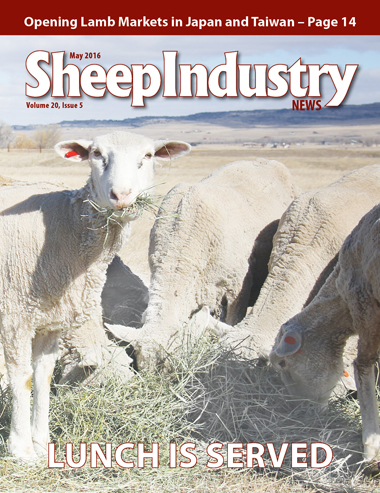To View the May 2016 Digital Issue — Click Here

Entering the Final Stages on Mandatory Price Reporting
Burton Pfliger, ASI President
I understand that within the industry sometimes it seems like we mention some topics over and over. In some instances, that is very much the case because they generally involve government, and that slows the schedule.
A four-year drive by ASI to update Livestock Mandatory Price Reporting rules is one such area. At least a couple of times a year we’ve mentioned this issue and its importance within the industry. Fortunately, we are in the very last step of updating the price reporting system for lamb. ASI comments were filed in April supporting the final rules that can be implemented by June. At that point, we shouldn’t have to work on reporting until the 2020 reauthorization.
One wrinkle that added to price reporting efforts this winter is the lack of public reporting that we depend on for LRP-Lamb insurance. Since early February, U.S. Department of Agriculture reports have cited confidentiality of companies and absence of certain weekly reports, therefore, insurance can’t be offered for sale. This situation, we believe, is due to the Mountain States Rosen purchase of the JBS lamb operation and due to the reluctance of USDA to publish cooperative numbers.
Staff and producer leaders have visited and met with USDA continuously since the ASI convention this winter supporting a decision on whether full reports will be available or not. We brought market analysts and company officials in to the conversations again in mid-April. I believe we will have a decision this spring and insurance will be fully operational again. Either way, we will keep you informed.
Another problem of not having formula carcass prices reported is that no one knows what lambs are worth when priced on a grid. In other words, we don’t know what lamb prices are when marketed on a carcass-value basis. The traditional lamb market appears weaker this winter, and it would certainly be helpful to document the market levels with a complete USDA Market Report.
The Bureau of Land Management in March issued a directive on how the agency will manage sheep grazing to sustain wild sheep. The goal of the directive ought to be balanced, as to sustain both domestic and wild sheep in our view. That is what multiple use of federal lands is, rather than single-use management in this case for one game species.
There are 80,000 plus wild sheep in the U.S., and across the west licenses are offered for hunting. The agency doesn’t manage exclusively for elk, deer or antelope, which are also game species.
ASI brought the directive to the attention of the U.S. Congress, which has been heavily involved in the U.S. Forest Service efforts to manage exclusively for wild sheep, with the request that they review and react to a similar drive by the Department of Interior. We were also disappointed that BLM provided detail only once during three meetings we had with them in February and March, and, in fact, industry leaders did not see the document until it was released to the general public on March 18. The agency describes the sheep industry input, but I can tell you it wasn’t input from ASI, and I doubt any state associations were involved either.
Your association executive board met by conference call in April with several key updates on issues and initiatives to address, including both topics already mentioned in this column.
ASI leaders continue to meet with pharmaceutical companies and federal officials on the Veterinary Feed Directive, which is to be implemented next January. We anticipate additional federal guidance regarding sheep and minor use drugs this summer, and are cautiously optimistic that a workable direction and time frame will be provided for sheep producers.
This is yet another topic that receives continual attention because of its importance, and the fact that the ultimate decision is not fully the sheep industry’s to make. You have to have private and government partners in the animal drug arena, so we work to keep communication open and ongoing.
Additionally, the executive board reviewed the nominations needed in May for the USDA American Lamb Board and the National Sheep Industry Improvement Center. We are encouraging individuals and state associations to share interest of sheep producers in serving on these boards and plan to submit the required forms by mid-May. Please visit Sheepusa.org for descriptions of the directors sought, and contact the ASI office or executive board members on interest.
Finally, the board reviewed the plans for comments to be submitted to USDA on the future of the U.S. Sheep Experiment Station. ASI has engaged a firm familiar with the station to assist in drafting the ASI comments to support continuing the station and sheep research. This will also be posted on our website in late April or early May to enable individuals and associations to use as a base for their comments.
The environmental impact statement the station has completed twice now states the preferred action is to continue the station and its sheep research. They found no adverse impact on grizzly bears or direct impact on wild sheep or sage grouse from continuing research.
We will critique the other options and strongly urge support for the preferred option.


